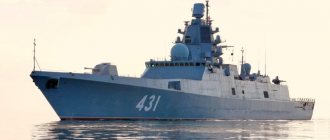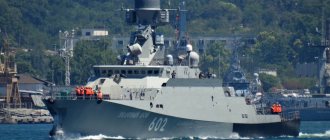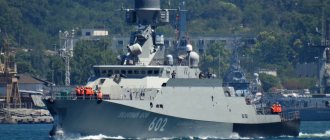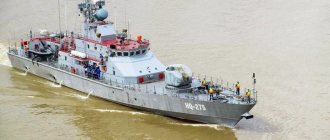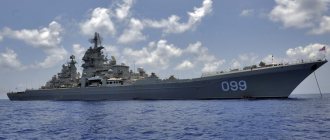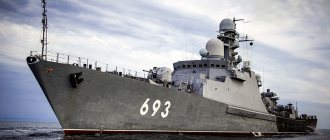The modern concept of development of the Russian Navy involves the construction of ships of various classes, but in some details Russia is a trendsetter in current shipbuilding. It was the Russian Navy that, at the beginning of the new millennium, began to receive the latest ships of curious design. Small in displacement and size, the ships had enormous firepower. The first trial was the construction of Project 21631 ships of the Buyan type, which in the West were classified as corvettes. A continuation of the successful project were the ships of Project 22800, in the design of which it was possible to implement all the latest developments.
Russian sea-launched cruise missiles "Caliber" have given a real impetus to the revival of a forgotten class of ships - small missile ships. Small, well-armed ships capable of operating simultaneously on rivers and at sea represent an effective tool for deterring military threats. The current Russian Karakurt-class corvettes, small and powerful ships, are in many ways similar to their predecessors - gunboats. Although not large in size and armed with powerful artillery, these ships were effective combat weapons in many navies.
Small rocket ships - Russian know-how
Today, the concept of building small missile ships for the domestic fleet is being implemented on the basis of real results and facts obtained. The idea is that a river-sea class ship with a small displacement can carry weapons of enormous power. Thanks to the advent of the Kalibr-NK cruise missile, this became possible. In addition, domestic shipbuilders had experience in building small ships of the corvette class. At first there were small artillery ships of Project 21630 of the Buyan type, built for the needs of the Caspian military flotilla. Further, the project was developed along the path of enhancing the combat capabilities of the ships. The improved project 21631 of the Buyan-M type already envisaged the construction of warships not with conventional artillery, but armed with a strike missile system.
The subsequent successful combat use of small missile ships as a strike force only confirmed the leadership of the fleet in the correctness of the chosen path for the development of small fleet forces. On October 7, 2015, small missile ships of the Caspian military flotilla “Uglich”, “Veliky Ustyug” and “Grad Sviyazhsk” launched Kalibr-NK cruise missiles against the targets of the Islamic State in Syria. The missiles, having flown 1.5 thousand km, hit the specified targets. This operation perfectly showed that small ships in the current conditions can represent an impressive fighting force. And this despite the fact that this type of ship was built for the advantage of operating in inland and coastal waters.
It became clear that with some changes made to the design of the RTOs, these small and formidable ships would be able to operate in remote maritime theaters. In this case, three weighty arguments were taken into account:
- ships of this class can be built at small shipyards;
- high rates of construction of combat ships;
- relatively low construction cost compared to the construction of larger ocean-going ships.
Moreover, due to small missile ships, Russia could significantly increase its naval power on the southern flank in a short period. The technical solution to this problem was the Project 22800 corvette. These small warships, with good seaworthiness and enormous firepower, can become a serious strike force for the Russian fleet at this time. The new project received a corresponding name - “Karakurt”. The small, stealthy ship can deliver a fatal blow to any enemy, both at sea and on land.
Karakurt is a poisonous spider that lives in arid regions. Despite its small size, the insect can inflict a fatal bite. The spider's venom affects the central nervous system, leading to paralysis of the heart muscle and respiratory system.
From "Scorpio" to "Buyans"
The desire to obtain modern seaworthy MRKs, designed according to the “cheap and cheerful” method, allowing in a fairly short time to create strike naval groups operating under the “umbrella” of coastal air defense, began to visit the naval command back in the “dashing nineties”. This was the starting point for the idea to build a series of missile and artillery boats of Project 12300 (code “Scorpion”) at the Almaz Central Marine Design Bureau at the beginning of the 2000s.
Having a total displacement of only 465 tons, the Scorpions were supposed to carry a 100-mm A-190E universal artillery mount with a rate of fire of 80 rounds per minute, the Kashtan-1 anti-aircraft missile and artillery system, and most importantly - 4 Yakhont vertical anti-ship missiles launch with a firing range of 300 km and a warhead weight of 200 kg.
The pre-production Scorpion was laid down on June 5, 2001 in Rybinsk on the stocks of the open joint-stock shipbuilding company Vympel. Initially, it was planned to deliver the boat to the customer in 2005, but... At first, the completion of the Scorpion was slowed down by a lack of funding, and later the military completely lost interest in Almaz’s brainchild. This was explained by the fact that the Scorpion was “narrowly tailored” to operate only against surface targets.
At the same time, the Novator Experimental Design Bureau named after L. V. Lyulev was already successfully completing work on the creation of the Caliber missile system. The wide range of Caliber missiles made it possible to hit not only surface but also ground targets.
At the same time, from the same universal ship firing complex it was possible to launch supersonic anti-ship missiles, which were the main lethal “trump card” of the little Scorpio. It is worth noting that the launch range of the Caliber exceeded 500 km, which de facto violated the terms of the Intermediate-Range Nuclear Forces Treaty (INF Treaty). But since the Calibers were declared as sea-based and not land-based missiles, de jure they did not violate the INF Treaty.
In general, the military leadership wanted to get something more versatile and long-range than the Scorpion, albeit at a higher price. As a result, the firstborn of Project 12300 remained unfinished, because “Caliber” did not fit into it! But the Zelenodolsk design bureau had both experience in creating Russia’s first rocket ship with “Caliber”, “Tatarstan” of Project 11661K, and also in the construction of 500-ton small artillery ships of Project 21630 (code “Buyan”), designed for the Caspian waters.
Unlike the Scorpion, it turned out to be much easier to convert the Buyany to the Caliber, with the accompanying increase in the tonnage of the ships by almost doubling. That’s what the Zelenodolsk residents did with the blessing of the state, receiving at the output the already familiar Buyany-M.
The accelerated construction of such compact warships, but with a high strike potential, raised a lot of questions among analysts. The latter disappeared only on October 7, 2015, when, as already mentioned, 3 Buyana-M and Tatarstan fired from the Caspian Sea at targets in Syria with Calibers.
But, with all the advantages that Project 21631 has, during the operation of the Buyanov-M on the Black Sea, the Zelenodolsk RTOs also revealed the disadvantages that we listed at the beginning of the article.
Birth of the project and construction of ships
Project 22800 can easily be called one of the most daring and successful domestic developments in the field of military shipbuilding. The main idea of the project is to create a short-sea ship of small displacement with developed weapons, which include defensive and strike systems. Based on the previous project of the Buyan-class small missile ship, the designers proposed limiting the displacement of the new ships to 800 tons. The ships should become universal combat units, capable of solving a wide range of combat missions, both as part of a naval formation and independently.
As before, the development of the project was carried out by the St. Petersburg Central Design Bureau "Almaz". This company has extensive experience in creating warships of all classes and types. The designers tried to use existing engineering and technological developments from previous similar projects. Project 12300 missile boats and Project 21631 small missile ships of the Buyan-M type were taken as a model. It was planned, using the design of existing ships, to increase the seaworthiness of the new ship. It was planned to build ships of the new project in three modifications: a patrol version, an anti-submarine version and an attack version.
The general public first learned about the new development of the domestic defense industry in the summer of 2015, when the model of the new ship was first demonstrated. Five months later, in December of the same year, the first two units of the Uragan and Typhoon MRKs were laid down. The lead ship was named in memory of the first Russian-built patrol ship “Uragan”. The order for the construction of new combat ships for the domestic fleet was received by the St. Petersburg Shipbuilding Plant. The naval command plans to build 18 ships of this class, which will be built at several shipyards at once. For the Pella shipyard, plans for the coming years include the construction of 7 Project 22800 warships, which should use the production capacities of other shipbuilding enterprises. If the first ships were laid down in St. Petersburg at the production site in Otradnoye, then the next two serial ships are already being built at the shipbuilding production facilities. The construction of the remaining ships in accordance with the State Order was distributed as follows:
- Shipyard “More”, Feodosia”;
- Shipyard "Zaliv" Kerch;
- Zelenodolsk shipyard Zelenodolsk Republic of Tatarstan;
- Amur Shipyard, Komsomolsk on Amur.
The distribution of government orders for the construction of small rocket ships was not done by chance. In each individual case, we can say that the construction of ships is carried out as part of the program for replenishing the Baltic, Black Sea and Pacific fleets. Following the first two ships that should be replenished with the Baltic Fleet, the shipyards in Otradnoye laid down the next two MRKs “Shkval” and MRK “Burya”, the place of service of which has not yet been determined. The first ships that can be added to the Black Sea Fleet should be the ships in the attack version “Storm” and “Okhotsk”, laid down in Feodosia in 2016-17.
The production capacity of the Zelenodolsk shipyard is already loaded with the construction of two karakurts, the Musson and Passat small-ship missiles. Three other ships are also ready to begin construction, contracts for the construction of which have already been signed. The technological capabilities of the Amur Shipyard are being studied to begin the construction of new generation ships, which, according to the plans of the military naval command, in the amount of 6 units will be transferred to the Pacific Fleet of the Russian Federation.
The construction of new rocket ships is being carried out at an active pace. In July-December 2022, it is planned to hand over to the acceptance committee the first two ships of Project 22800 “Uragan” and its analogue, the “Typhoon” rocket ship. In this case, the continuity of generations of warships can be traced. Almost 88 years ago, at the Nikolaev shipyard in Leningrad, the construction of Hurricane-class patrol ships began, which at that time became the main core of the young Soviet fleet. Today, the new Project 22800 missile ships continue the glorious tradition of their predecessors.
"Calibrated kayaks"
Almost simultaneously with the “calibration” of the fleet, the Russian military leadership had to solve another problem. The situation in the Black and Mediterranean Seas after the reunification of Crimea with Russia persistently required an urgent strengthening of the Black Sea Fleet. And first of all, shock units.
Since it was not possible to physically speed up the commissioning of Project 11356 frigates and Project 636 diesel-electric submarines intended to replenish the KChF, the Ministry of Defense took an unexpected step. It was decided to send the Serpukhov and Zeleny Dol MRKs of Project 21631 (code “Buyan-M”), originally created for the Caspian flotilla, to the Black Sea.
Of course, this was a palliative solution. "Buyan-M" were designed for operations in the closed waters of the Caspian Sea. They had dimensional restrictions caused by the need to fit into the dimensions of the locks, and also to pass under the spans of the bridges of the Volga-Baltic Waterway.
In general, the Project 21631 MRKs, with their water-jet propulsion systems, reduced seaworthiness and autonomy, were not particularly suitable for operations in the Black Sea and, especially, the Mediterranean. But the fact that each of the Buyanov-Ms could carry 8 subsonic Calibers or supersonic Onyxes for a long time, in the eyes of the military, made up for the above-mentioned shortcomings. Moreover, the strike potential of these RTOs was equal to that of the Project 11356 frigates, which are four times (!) larger than the Buyany-M in terms of displacement.
By the fall of 2016, it became clear to the Ministry of Defense of the Russian Federation that the continued presence of the Project 21631 MRK in the Black Sea Fleet was no longer justified. The Black Sea region was already quite tightly controlled by the ground forces and aviation of the Russian Armed Forces based in Crimea. At the same time, the KChF began to receive frigates and submarines, i.e. new “caliber carriers” with much better seaworthiness and autonomy than the Buyanov-M.
For this reason, Serpukhov and Zeleny Dol were sent to the Baltic, which was more suitable for Buyan-M in terms of basing and operating conditions. This saved the “calibre-carrying kayaks,” as Project 21631 MRKs were called behind the scenes on the Black Sea, from service “on the verge of heroism.”
The urgent problem for the entire Russian Navy of the speedy replenishment of the ship's personnel with new “caliber carriers” with more acceptable indicators of autonomy and seaworthiness than that of the Buyanov-M, now had to be solved by the Project 22800 MRKs already under construction.
To understand where these ships came from, we will have to mentally go back 16 years.
Features of Project 22800 ships
All vessels of the project, which are currently being built within the framework of the State order, must be transferred to the fleets by 2022. The ships that will be built in the Far East should be ready by 2022.
According to military experts, the Karakurt-class MRKs are river-sea class vessels that have been improved in accordance with the new operational-tactical situation that has developed on the flanks. In general, the new ships are universal combat units and should become an important component for strengthening the defense capability of the Russian Federation at sea.
The construction of seaworthy small platforms with a range of strike weapons can neutralize the threat created by the Russian naval forces in the European part and the Far East. The missile component, which is the main strength of this project, allows it to cover any targets within a radius of 1500-2000 km. The coverage area of sea-based Kalibr missile systems includes almost all land and sea targets in Western Europe and on the Pacific coast. From the Caspian Sea region, small missile ships are capable of covering targets in the Persian Gulf region. In other words, having a large group of ships of this class, the Russian Navy becomes capable of responding to any external threats.
The main innovation that distinguishes this project is the improved seaworthiness of the vessels. The ships, despite belonging to the “river-sea” class of vessels, gravitate more towards corvettes - ships capable of freely operating in the waters of coastal seas. With relatively modest dimensions: the length of the vessel is 67 meters and the width is 11 meters, the ships can withstand waves of up to 6-7 force. This was facilitated by an increase in the draft of the ships to 4 meters. The range of Project 22800 small missile ships remained the same as that of Project 21631 corvettes and amounted to 2,500 miles. But the navigation autonomy has increased, which has grown to 15 days.
The ship's hull also looks interesting. The geometry of the deck superstructures and the contours of the hull are designed taking into account low visibility. Special alloys are used as the main structural material, which can reduce the radar signature of the ship on radar screens. The presence of new and advanced radar and navigation equipment on Karakurt-class corvettes makes these ships sighted and secretive.
As for weapon systems, the new ships of the fleet have a combined weapons system. The main emphasis is on the Oniks anti-ship missile system and the Kalibr-NK cruise missiles that the ships are equipped with. The vertical launch units are located in the main control housing, immediately behind the conning tower. This arrangement of missile launchers makes it possible to profitably use the remaining deck space of the ship. In combination with strike weapons, new ships under construction will be equipped with the Pantsir-M anti-aircraft complex. Its tasks include creating a powerful and effective air defense of the ship against air attack of any kind. On the first two ships of the Uragan and Typhoon MRKs, air defense functions are performed by Ak-630M artillery mounts and Igla portable MANPADS.

